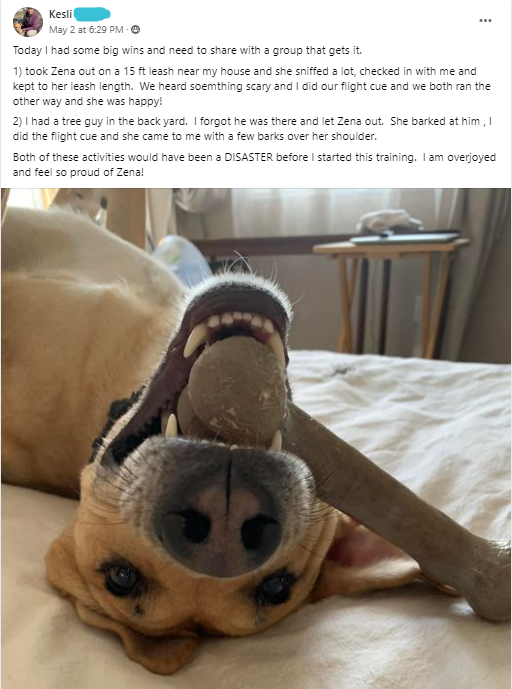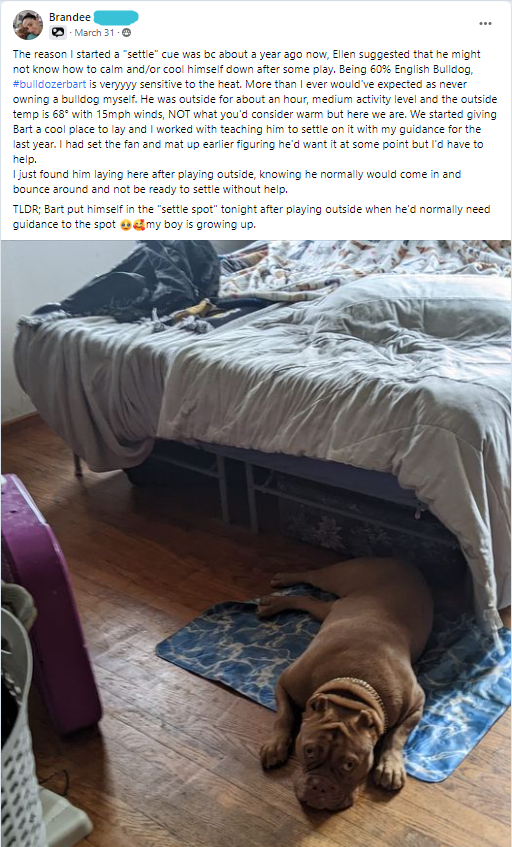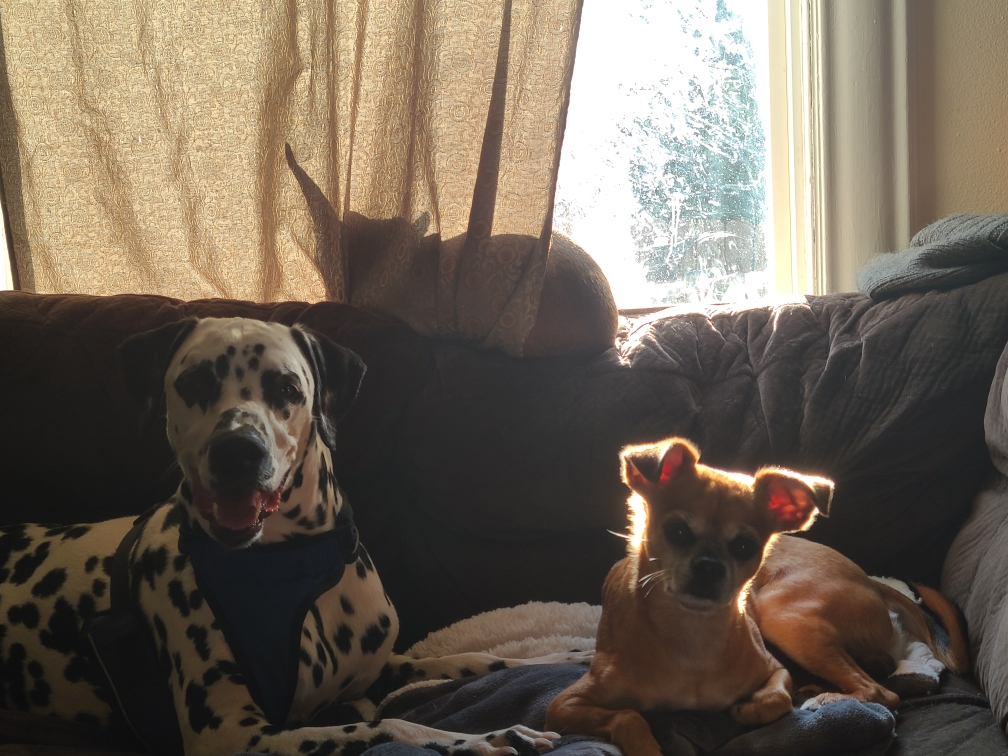We work with families that are experiencing issues ranging from mild annoyances to struggles that are greatly impacting the quality of life for everyone in the home. And as a team, we utilize the Pet Harmony Enrichment Framework to help us, our clients, and their pets to have a successful, sustainable behavior modification journey.
When people hear that we utilize enrichment to address behavior challenges, they sometimes are a bit skeptical. Whether they are a pet parent looking for assistance, a pet professional looking to better help the families under their guidance, or someone who is both, it’s not uncommon for them to wonder…
How do I incorporate enrichment into my behavior modification plan?
If you’re working with, living with, or addressing behavior challenges, you may think you have your “behavior modification plan” and then your “enrichment plan”.
But enrichment is all about meeting an animal’s needs, and that can look like a lot of different things. It isn’t an activity, it isn’t a toy or an object, it is the outcome of opportunities that our animal engages in.
Sometimes you need to teach skills to help better meet an animal’s needs and sometimes you need to better meet an animal’s needs before they can effectively learn new skills. We can’t neatly separate the two, and as you make progress in one area, you will see changes and developments in others. With each sliver of progress, you’ll unlock new ways to adjust your plan.
Once you start measuring enrichment by the outcomes, not the activity, it opens up so many new opportunities for you and your learner. It adds depth, richness, and flexibility to your plan.
When the root, the very foundation of your plan is to change behavior through meeting your animal’s needs, then enrichment is your behavior modification plan, not supplemental.
So, let’s look at some examples of why utilizing an enrichment framework is so important and celebrate some successes along the way!
Unmet needs can make teaching hard
If you are to look at what people often think of when they hear “behavior modification plans,” they are often focused on teaching a new skill or replacement behavior. The emphasis is on changing the behavior within the context that it occurs.
And yes, when we work with clients, this may also be a goal that we have! However, when we don’t look at the full picture of what the animal needs, we may fail to address something that’s impeding learning, such as an underlying medical condition, chronic stress, the need for behavior medication support, or other unmet needs that make learning difficult.
When we first start by making sure our animal is able to learn, that they receive any medical attention that is indicated, that they have the medication support to foster learning, that we’ve managed the environment and their stress, and/or identified any other roadblocks for them, then our teaching can really take hold. They can acquire new skills and learn to use them in new situations. We can teach them ways to better meet their own needs, and how to navigate the world more effectively.
From the human side of things, it is not uncommon for families to come to us who have already been trying to teach their animal something for weeks, months, or years. To get no results, or very few results can be frustrating and demoralizing. Taking a step back and meeting needs to foster learning can catapult your progress in incredible ways.
When we first started working together, Zena was barking at every little thing outside the house, through the windows, and in the backyard. Each little thing would send her into a tailspin that was difficult for her to recover from. The first step was to create an environment where Zena could learn, and as we discussed ways to decrease stress for the whole household, Zena’s person came up with the idea to use bubble wrap to cover the windows (without losing natural light!) and started utilizing sound masking to decrease auditory triggers.
A week later we touched base, and those small adjustments led to improvements for everyone. Zena’s barking and reactivity decreased significantly, the rest of the house also had less stress, and Zena’s person saw that Zena was able to learn in ways she had never seen before.
Meeting needs addresses the fuel, not just the flames
When we start by addressing unmet needs, then we are addressing the issue at the source. No fuel, no fire.
And let’s talk about what happened next with Zena! Once Zena was in a place where she was able to learn effectively and efficiently, Zena’s person was then able to teach Zena what to do instead of running, screaming, spinning, and yelling at all the little triggers. Zena was using all her bluster and might to get the things to go away. A person passing outside? Bark and they go away. Dog barking outside? Bark and they go away.
Zena needed space. She needed distance from the things and the only way she knew how to get it was to go on the offensive. So, we taught her how to get the distance in a way that didn’t disrupt the whole household, and frankly, was more effective!
By seeing and acknowledging that Zena needed space from the things she found stressful, we were able to teach Zena, not only how to get distance on her own, but how to get distance and relief at the same time through the Flight Cue. Now that Zena is well practiced in walking away and finding relief, she’s able to do it unprompted, and with other stressors in her life. While we are working on teaching her that she doesn’t need to be stressed about those things, she’s made incredible progress just by having the agency to move away from uncomfortable things, and without that skill, we couldn’t teach her that the mailman isn’t a threat to her very existence as efficiently and effectively.
 Comment reads: “Today I had some big wins and need to share with a group that gets it.
Comment reads: “Today I had some big wins and need to share with a group that gets it.
1) I took Zena out on a 15 ft leash near my houe and she sniffed a lot, checked in with me and kept to her leash length. We heard something scary and I did our flight cue and we both ran the other way and she was happy!
2) I had a tree guy in the back yard. I forgot he was there and let Zena out. She barked at him, I did the flight cue and she came to me with a few barks over her shoulder. Both of these activities would have been a DISASTER before I started this training. I am overjoyed and feel so proud of Zena!”
Meeting needs promotes sustainability
One of my favorite examples of this is Barty Boy Neutron, a well-intentioned cyclone of a pup who was running his family ragged. They were doing ALL THE THINGS with Barty Boy, trying to meet all his needs, and still, even after HOURS of activities, Bart would parkour all over the house every evening.
They tried all sorts of physical activity, foraging, and mental stimulation. They were dedicated to giving Barty everything he needed, but what they were doing wasn’t sustainable, safe, or realistic in the long run. So, we dove a little deeper into what Bart might need. He was getting adequate exercise. He was getting lots of mental stimulation, and foraging opportunities. He was partaking in lots of dog-typical things like sniffing, chewing, and licking.
One of the things his people did observe is that he ran hot. He would seek out cool spots in the house. So, his family crafted him the perfect cool place to help him self-regulate his temperature. Once he had a nice cool place to relax and settle, we saw giant improvements in his nightly routine, and his family was able to execute a sustainable routine to keep him happy, healthy, and safe.

Comment reads: “The reason I started a “settle” cue was bc about a year ago, Ellen suggested that he might not know how to calm and/or cool himself down after some play. Being 60% English Bulldog, #bulldozerbart is veryyyy sensitive to the heat. More than I ever would’ve expected as never owning a bulldog myself. He was outside for about an hour, medium activity level and the outside temp is 68* with 15mph winds, NOT what you’d consider warm but here we are. We stated giving Bart a cool place to lay and I worked with teaching him to settle on it with my gudiance for the last year. I had set the fan and mat up earlier figuring he’d want it at some point but I’d have to help.
I just found him laying here after playingoutside, mnowing he normally would come in and bounce around and not be ready to settle without help.
TLDR: Bart put himself in the “settle spot” tonight after playing outside when he’d normally need guidance to the spot. My boy is growing up!”
Meeting needs helps the entire family, not just one individual
When we’re sharing our space with other living creatures, our lives become acutely intertwined. When one being is struggling, it can impact the entire family unit. Using the Enrichment Framework takes into account all the beings involved, including the humans and the other pets.
In some instances, families that come to use are working on inter-household conflict, and whether that is dog-dog, dog-cat, dog-human, [insert species here]-[insert other species here], it is stressful for the entire family. Everyone in the home is walking on eggshells, and feeling secure in the place you’re supposed to feel safe can be difficult.
That was the case for Rylee’s family. Rylee, the dalamation pictured below, had started growling, snarling, and lunging at the other dogs and cats in the household. Family time was no longer something that felt comfortable and cup filling, instead, it was riddled with stress and grief.
By taking an approach to meet Rylee’s needs to help him engage with species-typical behaviors in healthy, safe, and appropriate ways, his family was able to make incredible progress. Each step on their journey opened up new opportunities for them along the way. This involved working with their fantastic vets to meet his medical needs and that helped him to be in a place to learn. From there, we were able to teach him about his safety room, and with that progress, he was able to start communicating when things were just too much and he needed his safe space.
By addressing Rylee’s needs, the rest of the family is able to feel safe and secure moving around their home. And I mean, come on, look at that smile!

Meeting needs helps you and your pet learn skills that will help for a lifetime
Our pets are living beings with needs that will change as they age and develop. What one dog needs at 6 months, won’t be the same at 6 years, and that’s just a part of life!
When we take an approach to explore and meet our pet’s needs, we are taking an approach that will help us in the future. We are creating a more robust behavioral repertoire and a foundation that we can always return to if we hit a bump in the road. When we utilize an Enrichment Framework, we are building in checks and balances, we are taking a directed approach to behavior change that will help inform future decisions and adjustments.
And that brings us to Otis. Otis is a wonderful little pup that is learning that it is okay to be home alone. Otis’ person is working on teaching Otis skills to help him self-regulate, self-soothe, and to be safe and feel secure in their home. These are all things that directly translate to being able to be comfortable at home alone, but the exercises, activities, and skills that Team Otis is working on will do so much more than just that. They are building a strong relationship that can weather storms, Otis is learning predictable and safe patterns that will help him during life changes in the future, and they are building a system of communication that will help day in and day out.
Watching Otis breathe deeply while learning to spend time alone is a reminder that meeting an animal’s needs doesn’t always look like what you see on the internet. Sometimes, it takes information to know the true beauty and joy of what you’re seeing, and Team Otis is doing an incredible job.
All of this and more is why we suggest meeting needs first.
The majority of the time, if you jump straight to the “problem”, you’re going to miss out on the low hanging fruit, you may be doing things that are going to be ineffective or inefficient, and you may dread the process. Working through an Enrichment Framework can help you take a directed approach where you know that you’re meeting your needs and your animal’s needs.
Instead of thinking and treating enrichment as a supplement to your plan, center it in your plan, and your results might just surprise you.
Now what:
- If you are looking to implement the Pet Harmony Enrichment Framework with the pets in your life, then make sure you check out our free enrichment chart guide! We walk you through step-by-step how we start utilizing enrichment for lasting behavior change.
- If you are a professional that is still unsure how to implement enrichment as the center of your behavior modification plan, then come join us for a free upcoming webinar! Join 3 Strategies to Uplevel Your Consulting Skills to Solve Behavior Challenges: Happier pets, enthusiastic clients, & a more rewarding career using the Pet Harmony Enrichment Framework here.
Happy training,
Ellen
